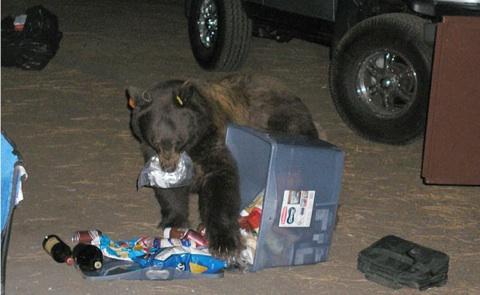
Thanks to a strong campaign to educate park visitors to keeping food away from bears, and by providing more food storage options, images like this are becoming few and far between at Yosemite National Park/NPS
A commitment to educating park visitors about keeping food out of the reach of bears and working to improve food storage options has resulted in 2015 producing the lowest number of human-bear incidents at Yosemite National Park since 1975, according to park officials.
This year so far the park has recorded 76 incidents, which resulted in $4,909 in property damage. (A bear incident occurs when a bear causes property damage, obtains food, acts aggressively, or injures a person.) This represents a 95 percent reduction in number of incidents and a 99 percent reduction in property damage from the record high in 1998, when there were approximately 1,600 incidents resulting in $660,000 in property damage, a park release said. Although injuries are relatively uncommon and minor, this year also marked the fourth year in a row in which there were no injuries caused by bears in Yosemite.
In 1998, dozens of black bears broke into cars and roamed campgrounds looking for food. It was not uncommon on a summer evening for bears to break into 10 to 15 cars. Most of these cars contained food, leading bears to become food conditioned. Additionally, many park visitors failed to store their food properly at campsites and picnic areas. The number of incidents escalated for several years in the mid-1990s. National media reported extensively on Yosemite’s human-bear conflicts, which caught the attention of a U.S. representative from California. To help curb the problem and educate park visitors, the congressman secured $500,000 per year for Yosemite to address human-bear conflicts and implement solutions.
With the high number of human-bear incidents and extensive property damage, the park used the additional funding to decrease incidents by reducing the availability of human food to bears and improving food storage facilities. In 2000, the park unveiled the “Keep Bears Wild” campaign, which continues today. The campaign focuses on educating visitors and employees about their responsibility to store food properly while visiting Yosemite. Park rangers continue to educate visitors in person, produce videos, post signs, distribute flyers, and work with the news media to improve public awareness. Delaware North at Yosemite includes messaging in its restaurants and on grocery bags and paper cups. Yosemite Conservancy offers retail products, such as stuffed bears with ear tags containing an educational message, to increase awareness and help fund bear awareness programs.
With extensive messaging throughout the park, visitors became more aware of how their individual actions could save a bear’s life. The program saw incremental improvement in ensuing years as food storage improved, with a dramatic reduction in incidents beginning in 2011.
“We would like to thank park visitors for their help in making this campaign an overwhelming success,” said Yosemite Superintendent Don Neubacher. “There is no more of a rewarding experience than seeing a bear foraging naturally.”
Even during a year with low incidents like this one, the work is not done. The park must continue to educate the public and visitors need to continue to store their food properly in order for this success to continue.
Yosemite Conservancy, the park’s philanthropic partner, has been instrumental to the success of the bear program on several levels. Yosemite Conservancy provided funding for several hundred of the bear-proof food lockers at campgrounds, trailheads, and parking lots. Last year, Yosemite Conservancy also provided funding to outfit bears with GPS collars. The GPS collars allow park rangers to track bears’ movements to learn about their habits. This has provided invaluable knowledge in learning about Yosemite’s bears.



Comments
This is a great success story....keep it up...and good for the representative from California !! At last someone's good idea came to fruition !! Bravo !!